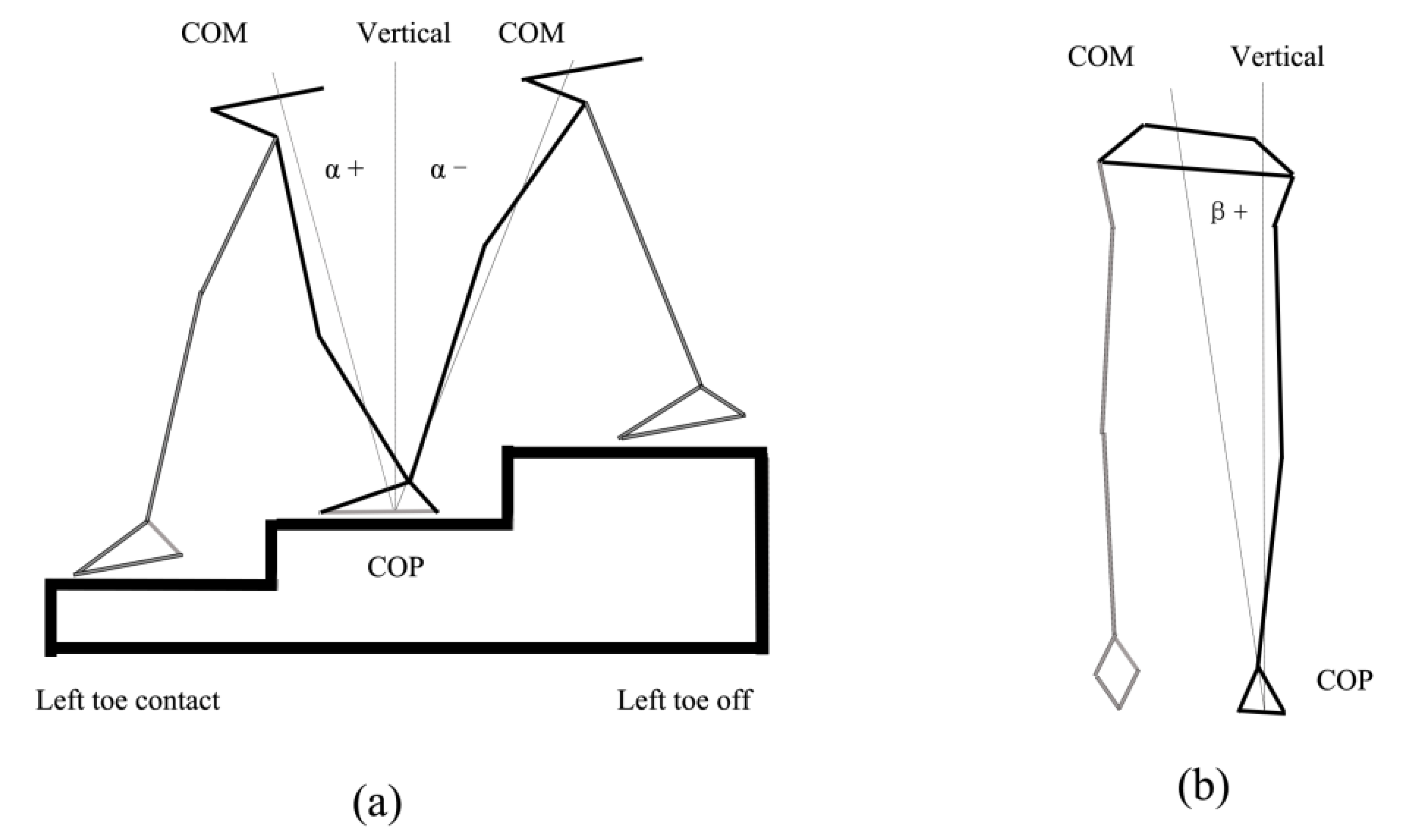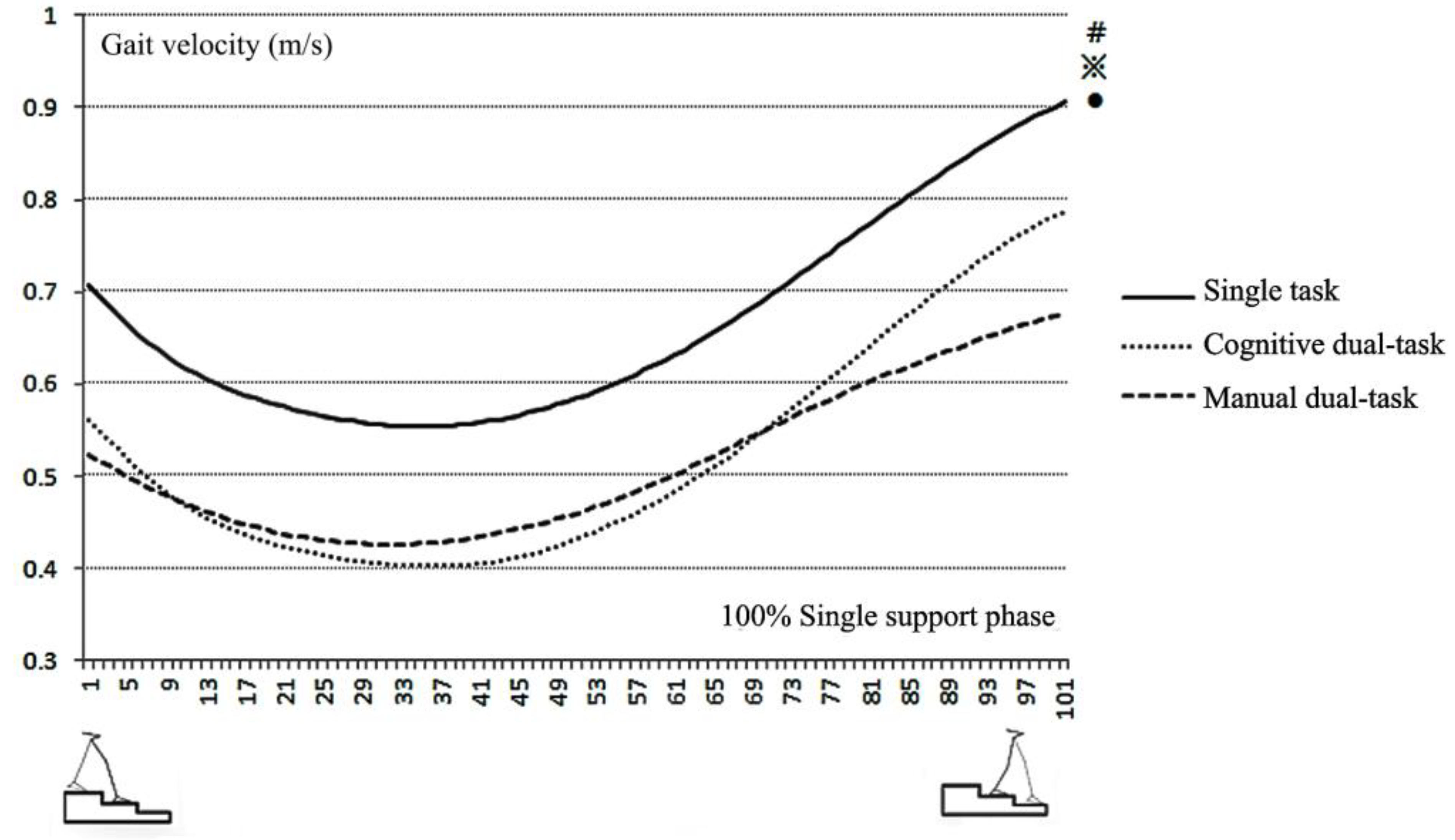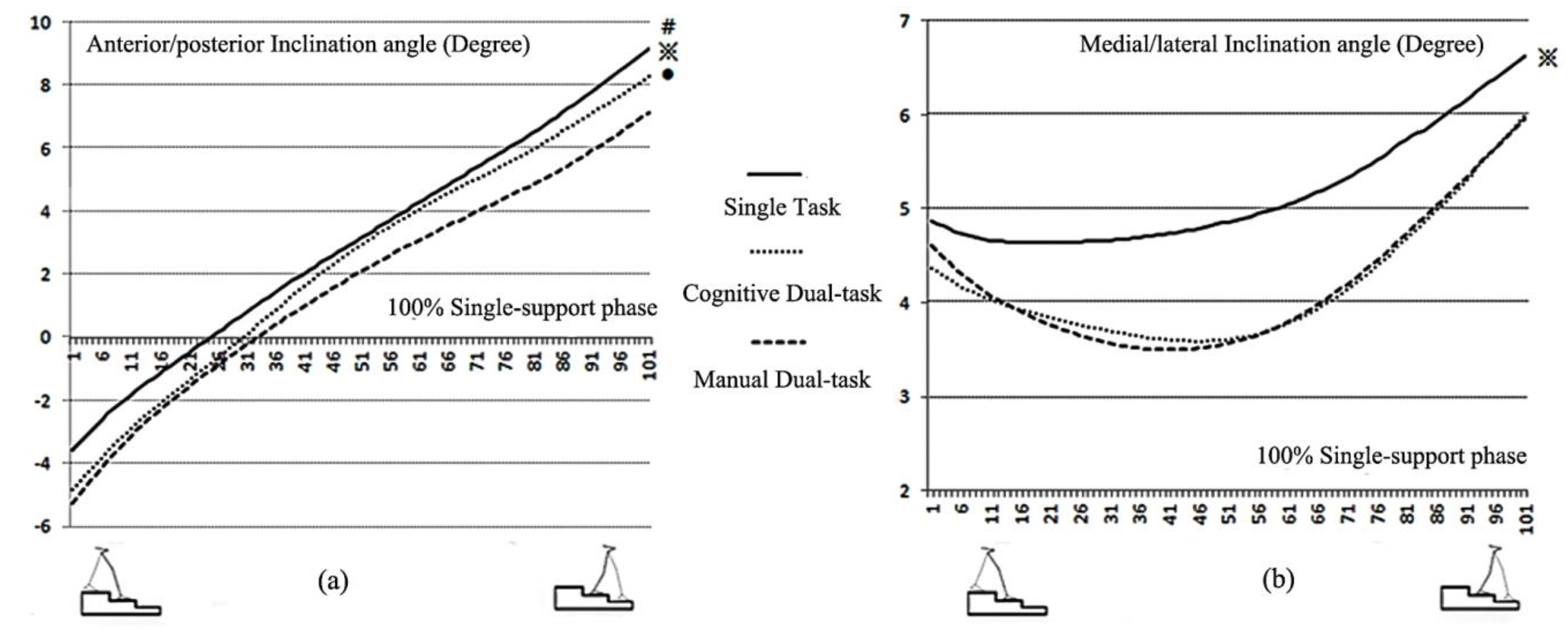Effects of a Dual-Task Paradigm and Gait Velocity on Dynamic Gait Stability during Stair Descent
Abstract
Featured Application
Abstract
1. Introduction
2. Materials and Methods
2.1. Participants
2.2. Apparatus
2.3. Study Protocol and Data Collection
2.4. Data Analysis
2.5. Statistical Analysis
3. Results
4. Discussion
5. Conclusions
Author Contributions
Funding
Acknowledgments
Conflicts of Interest
References
- Antonio, P.J.; Perry, S.D. Quantifying stair gait stability in young and older adults, with modifications to insole hardness. Gait Posture 2014, 40, 429–434. [Google Scholar] [CrossRef]
- Buckley, J.G.; Heasley, K.; Scally, A.; Elliott, D.B. The effects of blurring vision on medio-lateral balance during stepping up or down to a new level in the elderly. Gait Posture 2005, 22, 146–153. [Google Scholar] [CrossRef]
- Tinetti, M.E.; Speechley, M.; Ginter, S.F. Risk factors for falls among elderly persons living in the community. N. Engl. J. Med. 1988, 319, 1701–1707. [Google Scholar] [CrossRef]
- Qu, X. Effects of lower-limb muscular fatigue on stair gait. J. Biomech. 2015, 48, 4059–4064. [Google Scholar] [CrossRef]
- Bosse, I.; Oberlander, K.D.; Savelberg, H.H.; Meijer, K.; Bruggemann, G.P.; Karamanidis, K. Dynamic stability control in younger and older adults during stair descent. Hum. Mov. Sci. 2012, 31, 1560–1570. [Google Scholar] [CrossRef]
- Hashish, R.; Toney-Bolger, M.E.; Sharpe, S.S.; Lester, B.D.; Mulliken, A. Texting during stair negotiation and implications for fall risk. Gait Posture 2017, 58, 409–414. [Google Scholar] [CrossRef]
- Wayne, P.M.; Hausdorff, J.M.; Lough, M.; Gow, B.J.; Lipsitz, L.; Novak, V.; Macklin, E.A.; Peng, C.K.; Manor, B. Tai Chi Training may Reduce Dual Task Gait Variability, a Potential Mediator of Fall Risk, in Healthy Older Adults: Cross-Sectional and Randomized Trial Studies. Front. Hum. Neurosci. 2015, 9, 332. [Google Scholar] [CrossRef]
- Nordin, E.; Moe-Nilssen, R.; Ramnemark, A.; Lundin-Olsson, L. Changes in step-width during dual-task walking predicts falls. Gait Posture 2010, 32, 92–97. [Google Scholar] [CrossRef]
- Madehkhaksar, F.; Egges, A. Effect of dual task type on gait and dynamic stability during stair negotiation at different inclinations. Gait Posture 2016, 43, 114–119. [Google Scholar] [CrossRef]
- Asai, T.; Misu, S.; Doi, T.; Yamada, M.; Ando, H. Effects of dual-tasking on control of trunk movement during gait: Respective effect of manual- and cognitive-task. Gait Posture 2014, 39, 54–59. [Google Scholar] [CrossRef]
- Taylor, M.E.; Delbaere, K.; Mikolaizak, A.S.; Lord, S.R.; Close, J.C. Gait parameter risk factors for falls under simple and dual task conditions in cognitively impaired older people. Gait Posture 2013, 37, 126–130. [Google Scholar] [CrossRef]
- Morioka, S.; Hiyamizu, M.; Yagi, F. The effects of an attentional demand tasks on standing posture control. J. Physiol. Anthropol. Appl. Hum. Sci. 2005, 24, 215–219. [Google Scholar] [CrossRef]
- de Lima, A.C.; de Azevedo Neto, R.M.; Teixeira, L.A. On the functional integration between postural and supra-postural tasks on the basis of contextual cues and task constraint. Gait Posture 2010, 32, 615–618. [Google Scholar] [CrossRef]
- Song, Q.; Tian, X.; Wong, D.; Zhang, C.; Sun, W.; Cheng, P.; Mao, D. Effects of Tai Chi Exercise on body stability among the elderly during stair descent under different levels of illumination. Res. Sports Med. 2017, 25, 197–208. [Google Scholar] [CrossRef]
- Lee, H.J.; Chou, L.S. Balance control during stair negotiation in older adults. J. Biomech. 2007, 40, 2530–2536. [Google Scholar] [CrossRef]
- Kim, H.D. A Comparison of the Center of Pressure during Stair Descent in Young and Healthy Elderly Adults. J. Phys. Ther. Sci. 2009, 21, 129–134. [Google Scholar] [CrossRef][Green Version]
- Mian, O.S.; Narici, M.V.; Minetti, A.E.; Baltzopoulos, V. Centre of mass motion during stair negotiation in young and older men. Gait Posture 2007, 26, 463–469. [Google Scholar] [CrossRef]
- Lu, H.L.; Kuo, M.Y.; Chang, C.F.; Lu, T.W.; Hong, S.W. Effects of gait speed on the body’s center of mass motion relative to the center of pressure during over-ground walking. Hum. Mov. Sci. 2017, 54, 354–362. [Google Scholar] [CrossRef]
- Hsue, B.J.; Miller, F.; Su, F.C. The dynamic balance of the children with cerebral palsy and typical developing during gait. Part I: Spatial relationship between COM and COP trajectories. Gait Posture 2009, 29, 465–470. [Google Scholar] [CrossRef]
- Lu, H.L.; Lu, T.W.; Lin, H.C.; Hsieh, H.J.; Chan, W.P. Effects of belt speed on the body’s center of mass motion relative to the center of pressure during treadmill walking. Gait Posture 2017, 51, 109–115. [Google Scholar] [CrossRef]
- Chien, H.L.; Lu, T.W.; Liu, M.W. Control of the motion of the body’s center of mass in relation to the center of pressure during high-heeled gait. Gait Posture 2013, 38, 391–396. [Google Scholar] [CrossRef] [PubMed]
- Reeves, N.D.; Spanjaard, M.; Mohagheghi, A.A.; Baltzopoulos, V.; Maganaris, C.N. Influence of light handrail use on the biomechanics of stair negotiation in old age. Gait Posture 2008, 28, 327–336. [Google Scholar] [CrossRef] [PubMed]
- Lee, H.J.; Chou, L.S. Detection of gait instability using the center of mass and center of pressure inclination angles. Arch. Phys. Med. Rehabil. 2006, 87, 569–575. [Google Scholar] [CrossRef] [PubMed]
- Lu, H.L.; Lu, T.W.; Lin, H.C.; Chan, W.P. Comparison of body’s center of mass motion relative to center of pressure between treadmill and over-ground walking. Gait Posture 2017, 53, 248–253. [Google Scholar] [CrossRef] [PubMed]
- Huang, S.C.; Lu, T.W.; Chen, H.L.; Wang, T.M.; Chou, L.S. Age and height effects on the center of mass and center of pressure inclination angles during obstacle-crossing. Med. Eng. Phys. 2008, 30, 968–975. [Google Scholar] [CrossRef] [PubMed]
- Choi, A.; Sim, T.; Mun, J.H. Improved determination of dynamic balance using the centre of mass and centre of pressure inclination variables in a complete golf swing cycle. J. Sports Sci. 2016, 34, 906–914. [Google Scholar] [CrossRef] [PubMed]
- Cayless, S.M. Slip, trip and fall accidents: Relationship to building features and use of coroners’ reports in ascribing cause. Appl. Ergon. 2001, 32, 155–162. [Google Scholar] [CrossRef]
- Simoni, D.; Rubbieri, G.; Baccini, M.; Rinaldi, L.; Becheri, D.; Forconi, T.; Mossello, E.; Zanieri, S.; Marchionni, N.; Di Bari, M. Different motor tasks impact differently on cognitive performance of older persons during dual task tests. Clin. Biomech. (Bristol Avon) 2013, 28, 692–696. [Google Scholar] [CrossRef]
- Gribble, P.A.; Tucker, W.S.; White, P.A. Time-of-day influences on static and dynamic postural control. J. Athl. Train. 2007, 42, 35–41. [Google Scholar]
- Song, Q.; Li, L.; Zhang, C.; Sun, W.; Mao, D. Long-term Tai Chi practitioners have superior body stability under dual task condition during stair ascent. Gait Posture 2018, 66, 124–129. [Google Scholar] [CrossRef]
- Chien, H.L.; Lu, T.W.; Liu, M.W. Effects of long-term wearing of high-heeled shoes on the control of the body’s center of mass motion in relation to the center of pressure during walking. Gait Posture 2014, 39, 1045–1050. [Google Scholar] [CrossRef] [PubMed]
- Sheehan, R.C.; Gottschall, J.S. At similar angles, slope walking has a greater fall risk than stair walking. Appl. Ergon. 2012, 43, 473–478. [Google Scholar] [CrossRef] [PubMed]
- McCrory, J.L.; Chambers, A.J.; Daftary, A.; Redfern, M.S. Ground reaction forces during stair locomotion in pregnant fallers and non-fallers. Clin. Biomech. (Bristol Avon) 2014, 29, 143–148. [Google Scholar] [CrossRef] [PubMed]
- Soangra, R.; Lockhart, T.E. Dual-Task Does Not Increase Slip and Fall Risk in Healthy Young and Older Adults during Walking. Appl. Bionics Biomech. 2017, 2017, 1014784. [Google Scholar] [CrossRef] [PubMed]
- Kelly, V.E.; Janke, A.A.; Shumway-Cook, A. Effects of instructed focus and task difficulty on concurrent walking and cognitive task performance in healthy young adults. Exp. Brain Res. 2010, 207, 65–73. [Google Scholar] [CrossRef] [PubMed]
- Yogev-Seligmann, G.; Hausdorff, J.M.; Giladi, N. The role of executive function and attention in gait. Mov. Disord. 2008, 23, 329–342. [Google Scholar] [CrossRef]
- Regnaux, J.P.; Roberston, J.; Smail, D.B.; Daniel, O.; Bussel, B. Human treadmill walking needs attention. J. Neuroeng. Rehabil. 2006, 3, 19. [Google Scholar] [CrossRef]
- Schaefer, S.; Jagenow, D.; Verrel, J.; Lindenberger, U. The influence of cognitive load and walking speed on gait regularity in children and young adults. Gait Posture 2015, 41, 258–262. [Google Scholar] [CrossRef]
- Jacobs, J.V.; Fujiwara, K.; Tomita, H.; Furune, N.; Kunita, K.; Horak, F.B. Changes in the activity of the cerebral cortex relate to postural response modification when warned of a perturbation. Clin. Neurophysiol. 2008, 119, 1431–1442. [Google Scholar] [CrossRef]
- Cuevas-Trisan, R. Balance Problems and Fall Risks in the Elderly. Phys. Med. Rehabil. Clin. N. Am. 2017, 28, 727–737. [Google Scholar] [CrossRef]
- Ojha, H.A.; Kern, R.W.; Lin, C.H.; Winstein, C.J. Age affects the attentional demands of stair ambulation: Evidence from a dual-task approach. Phys. Ther. 2009, 89, 1080–1088. [Google Scholar] [CrossRef] [PubMed]



© 2020 by the authors. Licensee MDPI, Basel, Switzerland. This article is an open access article distributed under the terms and conditions of the Creative Commons Attribution (CC BY) license (http://creativecommons.org/licenses/by/4.0/).
Share and Cite
Song, Q.; Sun, W.; Zhang, C.; Mao, M.; Li, L. Effects of a Dual-Task Paradigm and Gait Velocity on Dynamic Gait Stability during Stair Descent. Appl. Sci. 2020, 10, 1979. https://doi.org/10.3390/app10061979
Song Q, Sun W, Zhang C, Mao M, Li L. Effects of a Dual-Task Paradigm and Gait Velocity on Dynamic Gait Stability during Stair Descent. Applied Sciences. 2020; 10(6):1979. https://doi.org/10.3390/app10061979
Chicago/Turabian StyleSong, Qipeng, Wei Sun, Cui Zhang, Min Mao, and Li Li. 2020. "Effects of a Dual-Task Paradigm and Gait Velocity on Dynamic Gait Stability during Stair Descent" Applied Sciences 10, no. 6: 1979. https://doi.org/10.3390/app10061979
APA StyleSong, Q., Sun, W., Zhang, C., Mao, M., & Li, L. (2020). Effects of a Dual-Task Paradigm and Gait Velocity on Dynamic Gait Stability during Stair Descent. Applied Sciences, 10(6), 1979. https://doi.org/10.3390/app10061979




